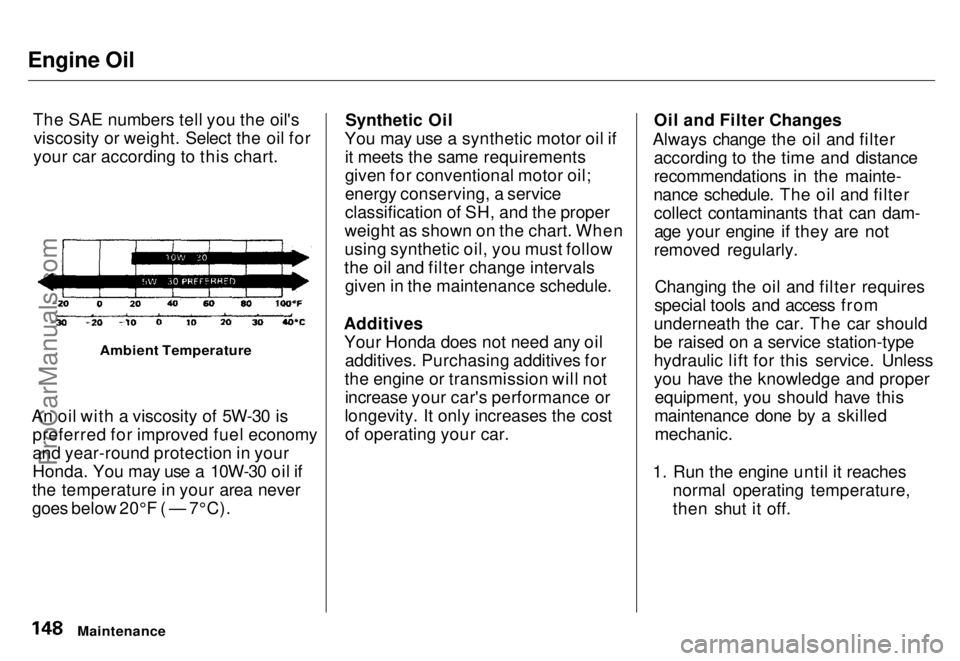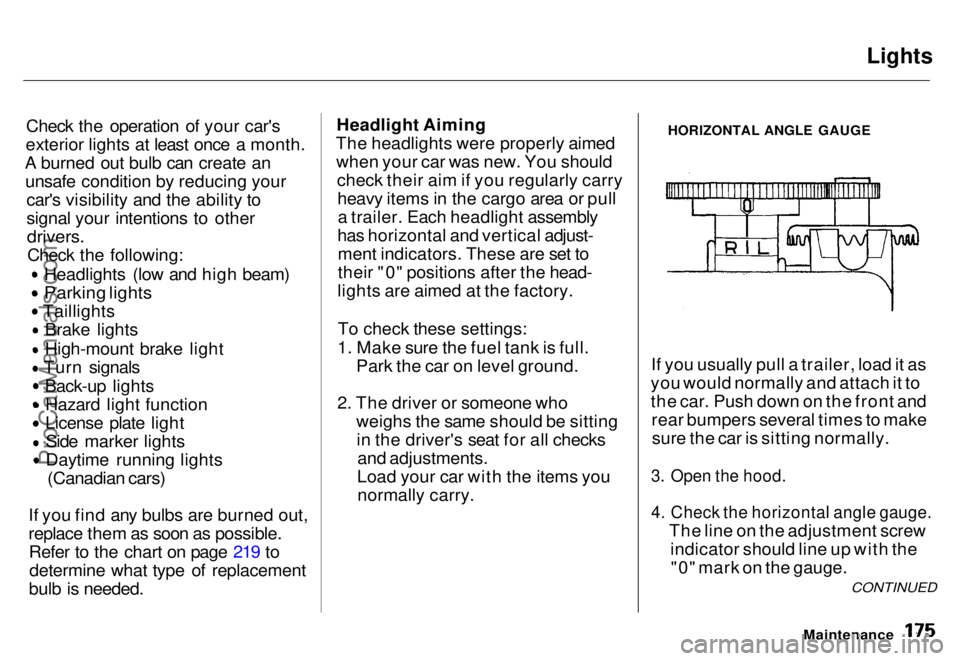Page 147 of 240

Engine Oil
The SAE numbers tell you the oil'sviscosity or weight. Select the oil for
your car according to this chart.
Ambient Temperature
An oil with a viscosity of 5W-30 is preferred for improved fuel economy
and year-round protection in your
Honda. You may use a 10W-30 oil if
the temperature in your area never
goes below 20°F ( — 7°C).
Synthetic Oil
You may use a synthetic motor oil if it meets the same requirements
given for conventional motor oil;
energy conserving, a service
classification of SH, and the proper
weight as shown on the chart. When
using synthetic oil, you must follow
the oil and filter change intervals given in the maintenance schedule.
Additives Your Honda does not need any oil additives. Purchasing additives for
the engine or transmission will not increase your car's performance or
longevity. It only increases the cost of operating your car. Oil and Filter Changes
Always change the oil and filter according to the time and distance
recommendations in the mainte-
nance schedule. The oil and filter collect contaminants that can dam-age your engine if they are not
removed regularly.
Changing the oil and filter requires
special tools and access from
underneath the car. The car should
be raised on a service station-type
hydraulic lift for this service. Unless
you have the knowledge and proper equipment, you should have this
maintenance done by a skilled
mechanic.
1. Run the engine until it reaches normal operating temperature,
then shut it off.
MaintenanceProCarManuals.comMain Menu s t Table of Contents
Page 174 of 240

Lights
Check the operation of your car's
exterior lights at least once a month.
A burned out bulb can create an unsafe condition by reducing your car's visibility and the ability to
signal your intentions to other
drivers.
Check the following: Headlights (low and high beam)
Parking lights
Taillights
Brake lights
High-mount brake light
Turn signals
Back-up lights
Hazard light function
License plate light
Side marker lights
Daytime running lights
(Canadian cars)
If you find any bulbs are burned out,
replace them as soon as possible. Refer to the chart on page 219 todetermine what type of replacement
bulb is needed. Headlight Aiming
The headlights were properly aimed when your car was new. You should check their aim if you regularly carryheavy items in the cargo area or pulla trailer. Each headlight assembly
has horizontal and vertical adjust- ment indicators. These are set to
their "0" positions after the head-
lights are aimed at the factory.
To check these settings:
1. Make sure the fuel tank is full. Park the car on level ground.
2. The driver or someone who weighs the same should be sittingin the driver's seat for all checks and adjustments.
Load your car with the items you normally carry. HORIZONTAL ANGLE GAUGE
If you usually pull a trailer, load it as
you would normally and attach it to
the car. Push down on the front and rear bumpers several times to makesure the car is sitting normally.
3. Open the hood.
4. Check the horizontal angle gauge.
The line on the adjustment screwindicator should line up with the"0" mark on the gauge.
Maintenance
CONTINUEDProCarManuals.comMain Menu s t Table of Contents
Page 240 of 240
Gas Station Information
Gasoline:
UNLEADED gasoline
Pump octane number of 86 or higher
Fuel Tank Capacity:
65 l (17.2 US gal, 14.3 Imp gal)
Recommended Engine Oil:
API SH grade
"Energy Conserving II" oilSAE 5W-30 viscosity Tire Pressure (measured cold):
Front/Rear:
220 kPa (2.2 kgf/cm2 , 32 psi)
Spare Tire Pressure:
420 kPa (4.2 kgf/cm2 , 60 psi)
Automatic Transmission Fluid:
Honda Premium Formula Auto-
matic Transmission Fluid or an
equivalent DEXRON ®
II type Auto-
matic Transmission Fluid (ATF)ProCarManuals.coms t Main Menu